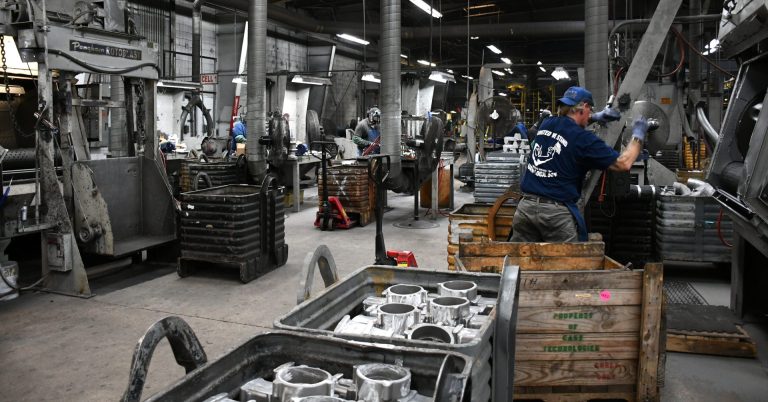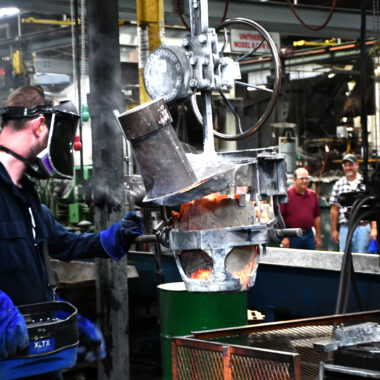Grasping Aluminum Casting: Proven Methods to Boost Production Efficiency
Grasping Aluminum Casting: Proven Methods to Boost Production Efficiency
Blog Article
Study the Globe of Aluminum Spreading: Comprehending the Various Methods
Aluminum spreading is a fundamental procedure in the production industry, with different methods utilized to develop intricate and exact parts. From the traditional sand casting technique to the advanced die spreading procedure, each method provides one-of-a-kind advantages depending on the demands of the job.
Sand Spreading Method
Sand spreading, a widely-used approach in light weight aluminum casting processes, involves creating mold and mildews made of compacted sand for pouring liquified steel. As soon as the mold and mildew is prepared, it is securely positioned in a flask and molten light weight aluminum is put into the cavity.
After the metal has actually cooled down and solidified, the sand mold is damaged away to disclose the aluminum casting. Sand spreading permits for the production of complex forms and huge components that may be pricey or tough to create using various other approaches. It is likewise a sustainable strategy as the sand can be recycled and used numerous times, minimizing waste in the casting procedure.
Long-term Mold Strategy

One significant advantage of the Permanent Mold Technique is the boosted dimensional precision it supplies. The steel mold and mildew permits for tighter resistances and finer details in the final aluminum spreadings contrasted to sand spreading techniques. This precision makes it a preferred option for applications where tight dimensional control is important, such as in the aerospace and automobile industries.

Pass Away Casting Refine

Investment Casting Method
Making use of an accuracy casting approach, Financial investment Casting Method involves developing complex aluminum parts by pouring molten steel into a ceramic mold and mildew. This process, also recognized as lost-wax casting, starts with the production of a wax pattern of the preferred part (aluminum casting).
Investment casting is generally used for producing parts in sectors where elaborate styles and limited tolerances are check that required, such as aerospace, automobile, and clinical tools. The versatility and precision of the Financial investment Casting Strategy make it a valuable technique in the world of light weight aluminum spreading.
Lost Foam Spreading Approach
Having actually explored the intricate precision of Investment Casting Method, the emphasis currently changes to the cutting-edge approach of Lost Foam Spreading in light weight aluminum component manufacturing. Lost Foam Casting, also called evaporative pattern casting, is a modern technique where a foam pattern of the preferred part is created and after that coated with a refractory product. The layered foam pattern is after that hidden in sand, and molten light weight aluminum is put right into the mold and mildew. As the metal fills up the mold, the foam evaporates due to the warmth, leaving a tidy dental caries in the form of the wanted component.
Among the major advantages of Lost Foam Casting is its capacity to generate complicated shapes with detailed information, commonly in a single item without the requirement for additional machining. This method is additionally understood for its high dimensional accuracy and smooth surface area finish. In Addition, Lost Foam Spreading is an affordable process as it lowers the requirement for cores and allows for the manufacturing of lightweight parts. In spite of its advantages, Lost Foam Spreading needs mindful control of the casting procedure to stop problems and make certain quality parts.
Verdict
To conclude, light weight aluminum spreading offers a range of approaches such as sand spreading, permanent mold strategy, pass away casting, investment spreading, and shed foam spreading. Each method has its own benefits and applications, making aluminum casting a flexible and widely used procedure in numerous industries. Understanding the distinctions in between these methods is crucial in selecting the most appropriate spreading strategy for specific production requirements.
Sand casting, a widely-used technique in light weight aluminum spreading procedures, entails developing mold and mildews made of compressed sand for putting liquified steel. aluminum casting.The Permanent Mold Technique, like sand casting, is another prevalent technique used in light weight aluminum spreading procedures, using distinctive benefits in terms of mold and mildew reusability and dimensional precision. The metal mold enables for tighter tolerances and finer details in the final light weight special info aluminum spreadings contrasted to sand spreading techniques. The two primary types of die casting are cool chamber pass away spreading and warm chamber die casting, each suitable for various kinds of light weight aluminum alloys.In final thought, aluminum casting offers a selection of approaches such as sand spreading, long-term mold method, die spreading, financial investment casting, and lost foam spreading
Report this page